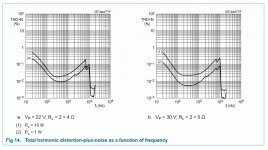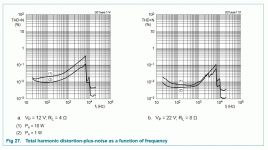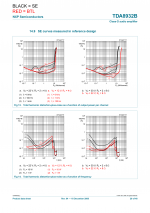This: TDA8950 120W 120W Class D Amplifier Board L | eBay Ebay#301442111174
I bought that thing after being impressed with the Sanwu TDA8932 altered to operate in SE mode (it does hi-fi in SE mode, not in bridge mode). And, big bro, the TDA8950, as presented by eBay has a visible flaw at the onboard power supply but no other obvious flaw. It seemed to need the one thing I'm good at, a fair linear supply system.
On first start-up, I was floored. Yes, I could hear the little obvious taint from the cheapest on-board power supply ever designed. However, that wasn't as bad as I thought it would be, and it doesn't sound like a Class D amplifier. It just sounds like a really good amplifier that might could use a better supply. I had not expected the factory condition to be either pleasant or relevant. However, it is both. This a fantastic surprise! This a cheapskate midfi, but as such it has done its job far better than expected.
It sounds a lot like little bro, except cheaper and more headroom.
Unlike its slightly better? little brother, the bigger job this thing does is expensive; so much that comparison is not really valid except for fun. This amp does $300 worth of fun at less than $40. It isn't that you couldn't get better, but rather that this amp defeats the scammers so thoroughly that you don't need to spend too much for nearly high end audio.
Therefore, the remainder of this thread should be be about increasing the resolution of this amplifier. Let's see what happens.
EDIT:
Turning down the volume knob also turns down the quality--you get a fuzzbox. I suggest to replace the volume pot with ordinary 100k resistors (for input load), or an even higher figure. See also posts #3 and #4. Control the volume with source, preamp or buffer, not the amplifier's volume pot.
I bought that thing after being impressed with the Sanwu TDA8932 altered to operate in SE mode (it does hi-fi in SE mode, not in bridge mode). And, big bro, the TDA8950, as presented by eBay has a visible flaw at the onboard power supply but no other obvious flaw. It seemed to need the one thing I'm good at, a fair linear supply system.
On first start-up, I was floored. Yes, I could hear the little obvious taint from the cheapest on-board power supply ever designed. However, that wasn't as bad as I thought it would be, and it doesn't sound like a Class D amplifier. It just sounds like a really good amplifier that might could use a better supply. I had not expected the factory condition to be either pleasant or relevant. However, it is both. This a fantastic surprise! This a cheapskate midfi, but as such it has done its job far better than expected.
It sounds a lot like little bro, except cheaper and more headroom.
Unlike its slightly better? little brother, the bigger job this thing does is expensive; so much that comparison is not really valid except for fun. This amp does $300 worth of fun at less than $40. It isn't that you couldn't get better, but rather that this amp defeats the scammers so thoroughly that you don't need to spend too much for nearly high end audio.
Therefore, the remainder of this thread should be be about increasing the resolution of this amplifier. Let's see what happens.
EDIT:
Turning down the volume knob also turns down the quality--you get a fuzzbox. I suggest to replace the volume pot with ordinary 100k resistors (for input load), or an even higher figure. See also posts #3 and #4. Control the volume with source, preamp or buffer, not the amplifier's volume pot.
Last edited:
Hmm, when looking the the datasheet i can't see the improved from SE over BTL. (TDA8932B)
Reference: http://www.nxp.com/documents/data_sheet/TDA8932B.pdf
SE:
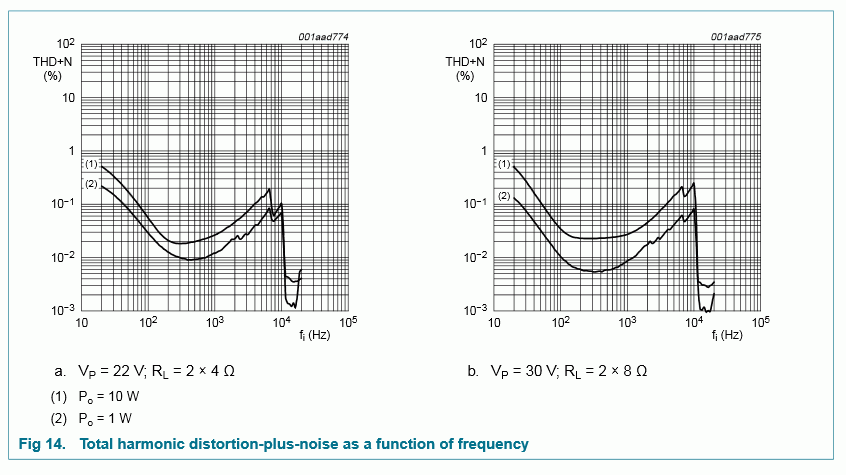
BTL:
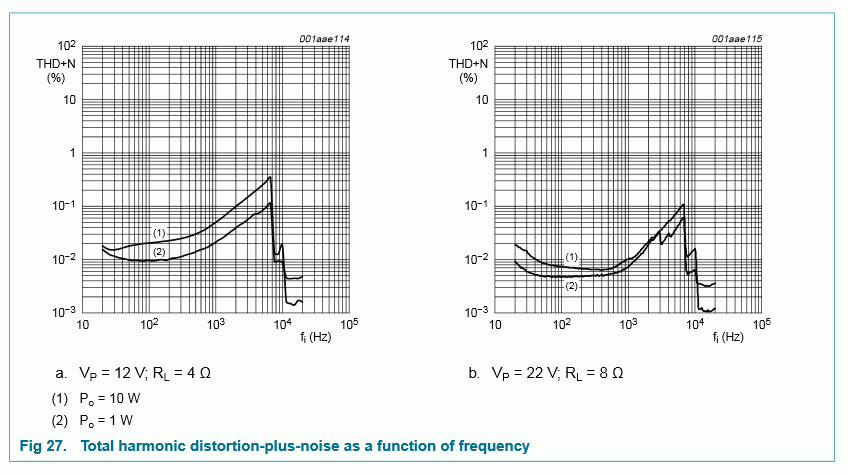
What does SE makes it more "HiFi" than BTL? From Figure 26, the BTL is a bit worse at the 6kHz frequency but this is really minor.
BTL: 0.35% at 10W VP=12V RL=4R
BTL: 0.15% at 10W VP=22V RL=4R
Regards,
Christian
Reference: http://www.nxp.com/documents/data_sheet/TDA8932B.pdf
SE:
BTL:
What does SE makes it more "HiFi" than BTL? From Figure 26, the BTL is a bit worse at the 6kHz frequency but this is really minor.
BTL: 0.35% at 10W VP=12V RL=4R
BTL: 0.15% at 10W VP=22V RL=4R
Regards,
Christian
Attachments
I have 8 of that excact module, and I hate them (eventhough I did love them for woofers). Have you tried to play solo piano? I have an irritating faint noise. I have recorded the noise. I also have distortion in opposite channel (that is left input creates noise in right output)
This is the faint noise distortion
https://onedrive.live.com/redir?resid=F0079C5A209BF197!13070&authkey=!AChwazIH4CG6wGA&ithint=video%2cmp4
and this is distortion in opposite channel
https://onedrive.live.com/redir?resid=F0079C5A209BF197!13073&authkey=!ADVxJVhdvLrmj-g&ithint=video%2cmp4
I have also had 10 moduels with same chip from Connexelectronic and they had the same issues. The issues are reported by many here at diyaudio.
And you do not have these issues?
This is the faint noise distortion
https://onedrive.live.com/redir?resid=F0079C5A209BF197!13070&authkey=!AChwazIH4CG6wGA&ithint=video%2cmp4
and this is distortion in opposite channel
https://onedrive.live.com/redir?resid=F0079C5A209BF197!13073&authkey=!ADVxJVhdvLrmj-g&ithint=video%2cmp4
I have also had 10 moduels with same chip from Connexelectronic and they had the same issues. The issues are reported by many here at diyaudio.
And you do not have these issues?
Last edited:
Fuzzbox effect happens with the volume pot.I have 8 of that exact module, and I hate them (even though I did love them for woofers). Have you tried to play solo piano? I have an irritating faint noise. I have recorded the noise. I also have distortion in opposite channel (that is left input creates noise in right output)
This is the faint noise distortion
https://onedrive.live.com/redir?resid=F0079C5A209BF197!13070&authkey=!AChwazIH4CG6wGA&ithint=video%2cmp4
and this is distortion in opposite channel
https://onedrive.live.com/redir?resid=F0079C5A209BF197!13073&authkey=!ADVxJVhdvLrmj-g&ithint=video%2cmp4
I have also had 10 moduels with same chip from Connexelectronic and they had the same issues. The issues are reported by many here at diyaudio.
And you do not have these issues?
Replace with resistors, like this:
Ground vias (farthest from the white connector) to center vias by 100k resistors.
and
Center vias to input vias (nearest the white connector) by 470R resistors (or perhaps just a short/jumper would do).
1/4 watt resistors fit fine standing up (put the wires at center).
That's like a 100k pot stuck at full blast.
Control volume with source or buffer or preamp.
If 100k wasn't quite satisfactory, why not try 250k?
That's also just a quick-fix. There's probably a different modification that would be more appropriate.
I noticed that when the ground to center/output connection on that volume pot goes below 40k, the fuzzbox effect starts, and is quite bad by the time the included 50k pot gets to 20k or smaller figures. Turning down the volume turns down the quality. Whiskey Tango Foxtrot??? Somehow it doesn't like current at that point--the amplifier's input load.
P.S.
I also noticed little full range in your video--the TDA8932 in SE mode would do a little bit better job for those. Try it with a linear regulator.
P.P.S.
I did not notice the volume control caveat of the TDA8950 because I was using a very weak modern source with onboard digital volume control, thus the board's pot was all the way up.
Last edited:
Why indeed would there be an audible difference in practice, with a music signal and a real speaker when the datasheet shows a minimal difference in lab conditions?To have a better comparison, i put both in the same diagrams. But still not seeing the point where SE makes it more "HiFi"?
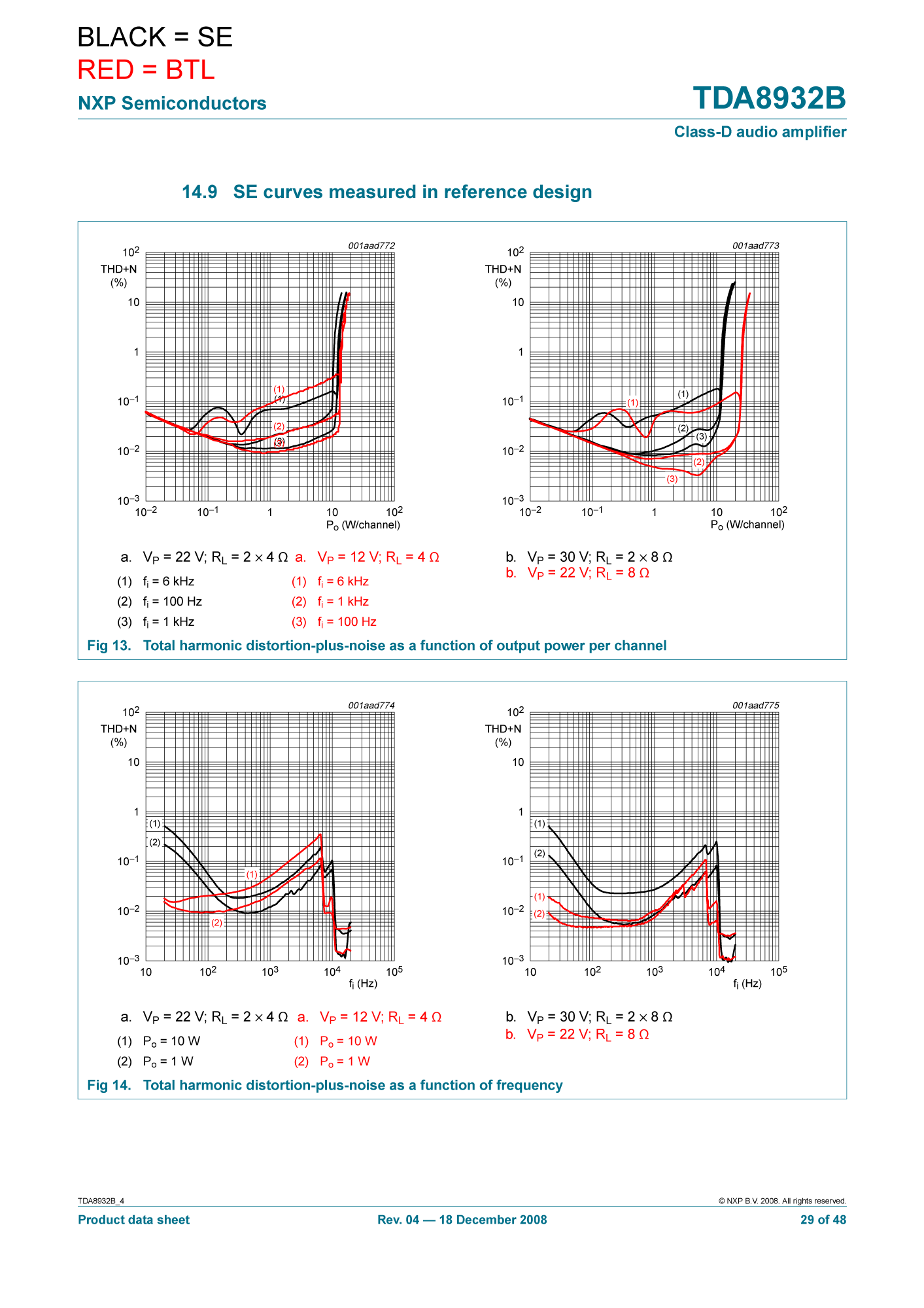
I apologize! I cannot answer that question sufficiently.
I will try, because asked. But, this will go badly. I am sorry for that.
What can I say that is meaningful? Bridging does have several advantages, such as headroom that is awfully good for fidelity, power supply management, and resistance to negative impedance glitches. Those are all sure to improve the fidelity of any speaker drivers responsible for the bottom half of the audio band. But, it really sucks for tweeters due to the degradation of linearity that such loading will do to the tiny output devices. Additional costs of a series connection, like bridging (amp-speaker-amp--that's series), are incurred when something is wrong with the amp.
This is not quite wrong. Maximizing stability while driving a real speaker, increases efficiency and promotes a placid, ear-friendly tone, in all or most conditions. In SE mode, you get that. But, when two such efforts go in series, for bridged, you get doubled costs, just the same costs as if you'd overdone the compensation by twice (two amps, series). I so hope I'm not totally flubbing the explanation, although my track record on that would probably indicate that this will go badly. Another moment for apologies! Sorry about that. Anyhow, two good intentions unexpectedly run series results in overkill. The cost is a "much less interesting" output from your tweeter. The datasheet does show it, but it did not show the extent of it, practically. The logical but utterly craptastic answer has to be that the tested conditions were different. That is lab conditions versus speaker. I've seen that before with RMAA, where I routinely have to re-size the graphs 10x higher. My test equipment (crude, cheap, free, pc based, and a bit of guess), typically shows the answer spot on, as well as utterly fails to represent a practical extent. Basically, frequency fine, amplitude foobar.
Consider this! Maybe the datasheet is correct, that the treble is unnoticeably worse when bridged and I'm just a hyper-sensitive person equipped with a specially rigged speaker to spot it. That's a really different way to say it, but it is so close to the truth that I wouldn't really be able to dispute it.
Frequency fine, amplitude foobar, test conditions different. That's as close as I can get to an engineerese language answer. I wish that I could do better, and it isn't for lack of effort, but I just don't have it. Well, there it is.
Instant replay (for sports fans):
Bridged could make a 4x benefit, if one didn't consider the effect of loading and, then it is much closer to 3x, with the remainder a cost to quality due to reduced linearity from heavily loaded tiny size transistors sealed up in a little black box where you can't really change that. That's great for a woofer, bad for a tweeter. Okay! Now, this amp has a factory fixed gain, fixed at placid for tame behavior, higher efficiency and ear-friendly results. That's fantastic, but the costs of it are doubled if bridged, and we can't adjust it, because fixed closed loop gain. For sure, that could cause some questions.
Some of the applications are confirmed gorgeous without peer. There are heavy cost to other applications.
I'm not sure whether to congratulate NXP or to cuss them out for making the products non-adjustable, but it wouldn't be overly difficult to use them properly; so, we probably shouldn't cuss them out for that one.
My meager measuring equipment does exactly the same as NXP's frequency spot on, amplitude nowhere close to practical. It is great that you asked my why, but unfortunately, I have no idea whatsoever.
Meanwhile, back on topic.
TDA8950
It ships in SE mode, with decent fidelity except for two errors--poor quality supply and something off with the input. On this board, the input is mis-made. Under the board, I find there's some BTL jumper here markings, totally unexplained. Something to do with the input system creates a fuzzbox effect if the amplifier is turned down at all via the included volume pot. Why does everyone with the TDA8950 report fuzzbox like distortion except for when the volume pot is set to max? I need your help. What should be corrected for the input of this amplifier?
Edit: I had another question. As poorly as these products work when bridged, why don't we reverse that by making some non-bridged Parallel mono amplifiers? Just a thought. For sure, you'd have all the quality they could do, plus doubled output device linearity to play with. Surely, that's not bad.
Last edited:
Thanks for the input. So there are two things you worry about, costs from BTL and nonlinearity of the transistors or mosfets. For the latter, to my knowledge, this doesn't apply as they're either ON or OFF, the magic of class-d. So non-linearity can only come from the AFE/input amplifier as this is analog. When feeding them differentially, they should cancel out.
When you using the amps in SE do you consider the problems from possible bus-pumping?
Have you tried ground the front metal part of the pot? You may also try to add 10nf in parallel with 100kohm from each input leg to gnd at the pot.
Regards-
When you using the amps in SE do you consider the problems from possible bus-pumping?
Why does everyone with the TDA8950 report fuzzbox like distortion except for when the volume pot is set to max? I need your help. What should be corrected for the input of this amplifier?
Have you tried ground the front metal part of the pot? You may also try to add 10nf in parallel with 100kohm from each input leg to gnd at the pot.
Regards-
The noise/distotion I hear is independent of volume settings. But I could try you trick, and also skip the onboard PSU. I also have tried grounding the metal part of the pot with no luck.
I also have modules from connexelectronic, and these a without pot, but still have the noise issue.
I also have modules from connexelectronic, and these a without pot, but still have the noise issue.
Last edited:
I managed to get the fuzz-box distortion with my TDA8932. I figure it was crosstalk from the output wires back to the input. I fixed it by fitting an input attenuator (i.e. series resistors) right on the pins of the IC with 0805 resistors. I think it was about -10dB. I also added a small cap but I think the fuzz-box effect went away even without the cap.
I was hoping that you read my comment so we could discuss it. Oh thanks! Swapping the volume pot to a 250k version looks promising, as a sort of probably working wrong fix. It just doesn't like loading between ground and amp input. Some sources would have enforced an impedance, and therefore, both lighter loading AND some series resistors may be needed (which would utterly block solid state like impedance enforcement). Pardon me--I'm having a problem with the language for this.The noise/distotion I hear is independent of volume settings. But I could try you trick, and also skip the onboard PSU. I also have tried grounding the metal part of the pot with no luck.
I also have modules from connexelectronic, and these a without pot, but still have the noise issue.
I really didn't experience any trouble with the fuzzbox-like distortion until I turned the volume control down from max, and then it was quite offensive! After that I de-soldered the volume pot, hastily. I replaced it with 100k load, 1k pass. It seemed like a great idea at the time. Unfortunately, I won't be able to replicate the fuzzbox problem now, and that is unfortunate only because it is uninformative.
Base stoppers? That's brilliant! I hadn't thought of it, but for sure, some padding/impedance at that locale would directly reduce the loading that it isn't fond of.I managed to get the fuzz-box distortion with my TDA8932. I figure it was crosstalk from the output wires back to the input. I fixed it by fitting an input attenuator (i.e. series resistors) right on the pins of the IC with 0805 resistors. I think it was about -10dB. I also added a small cap but I think the fuzz-box effect went away even without the cap.
It blocks the problem straightaway, but it doesn't help in identifying the problem.
It does seem to be a more inspired version of a technically incorrect fix. Reducing DC reference loading/current at that locale, works; however, there could be a cap missing. It looks like we should have a stare at the single rail applications to see if that approach might help. We do need to have a closer look at AC versus DC loading before determining that base stoppers is the best answer available. Sure, it might be, but I just don't know at this time.
EDIT: So far the good news is that there are available solutions and the locale for it has been spotted.
That is an additional problem. However, it is entirely different and un-related to the fuzzbox problem. The cheap power supply will cause the amplifier to be unpleasant when it is cranked up loud, so that is impractical to use it at its maximum potential because of blare, which is a practicality-biased and slightly costly problem. Fixing that will not help the fuzzbox input locale problem. They're quite different. One problem is at small signal, the input, and the other problem is at large signal (supply=speaker level=large signal). The two problems that the amplifier has are not related. In my opinion, and because there is gain, I think we have to fix the small signal problem first. The presence of a voltage gain stage forces the order of repairs to follow smallest to largest. So, we really must accomplish the input repair first....skip the onboard PSU...
I do still think this amplifier is promising, but a determination is still pending.
I suppose that the power supply costs won't be much different than for a high-end Class aB amplifier. Sure, the transformer and heatsink can be smaller sized for the Class D amplifier, but that's not much.I will dig up these modules again, and try out the solutions mentioned here. They are indeed very promising and not particularly Class D like. For pure bass amplification they are unbeatable for the price.
If you wanted to make thousands, then those economies might be important; but, if you wanted to make one for home use, the efficiency advantage, which wasn't much in practice, has evaporated.
Although some brags have not worked in practice, the remainder does seem to be capable of high fidelity audio... if you add the equipment for that.
It probably will be easy, but it won't be as cheap as claimed for Class D.
Last edited:
What was the value of the resistors?I managed to get the fuzz-box distortion with my TDA8932. I figure it was crosstalk from the output wires back to the input. I fixed it by fitting an input attenuator (i.e. series resistors) right on the pins of the IC with 0805 resistors. I think it was about -10dB. I also added a small cap but I think the fuzz-box effect went away even without the cap.
Thanks man! That totally makes sense.From memory I think I used 56k either side. The overall gain reduction was about 3X, running in BTL mode.
Also, the system gain won't go down unless the series elements also have a load. Was it the volume pot?
No, I put the volume pot prior to those resistors, on my input board.
The load is the built-in resistance of the chip. If you look at the DS, p12 shows what the input circuitry looks like. Remember in BTL mode you have two of these input circuits in parallel, so the impedance of each input to GND is about 25k.
The load is the built-in resistance of the chip. If you look at the DS, p12 shows what the input circuitry looks like. Remember in BTL mode you have two of these input circuits in parallel, so the impedance of each input to GND is about 25k.
Production of that has varied in the quality of decoupling caps provided. I sure do need to photograph that. Anyway, I do have that older one that was not suitable to use BTL but was delightful SE. I don't have a problem with prying (some heat involved too) all four inputs off the board to check this. Are you going to check it too?Yeah - I haven't tried 4 resistors because on the board I'm using the two inputs are already wired in parallel. So I went with just two resistors. If you wanted to use 4 they'd be larger valued because then each is looking into a higher load impedance (twice as high).
Thanks for the speedy reply.
P.S.
As far as the board relevant to this thread, I bought it for two reasons; that it would suit a transformer that I already own (undersize for Class aB amp but not terrible for Class D amp's slightly lower current needs) and that it looks (and is) easy to wipe out that ugly/economy onboard power circuit, scrape off all the traces from that area and re-purpose that board space for something easily done that works slightly better, along with the annoyance of building an off-board supply (a straightforward task costs a bit). Can I build an unreg supply that has TDA8950 sound as pretty as little brother TDA8932 on a cheap linear reg (or outdated "gets hot" SMPS)? I don't know, yet. But, there is that particular "paywall" before they can be compared fairly--a big capacity amp compared to a little one. The matter might be linear in comparison to the output power.
Thanks again for the confirmation on the locale of the input trouble (too much current with those crossed up inputs); and now, for this thread, we can proceed to the power supply.
Last edited:
- Status
- This old topic is closed. If you want to reopen this topic, contact a moderator using the "Report Post" button.
- Home
- Amplifiers
- Class D
- Big bro, the TDA8950
